Overview Page
The Overview dashboard is your command center for understanding how your brand performs in the evolving landscape of AI-powered search. As AI platforms like ChatGPT, Perplexity, and Google's AI Mode increasingly shape how users discover information, this dashboard provides critical insights into your brand's visibility, competitive positioning, and content performance across these platforms.
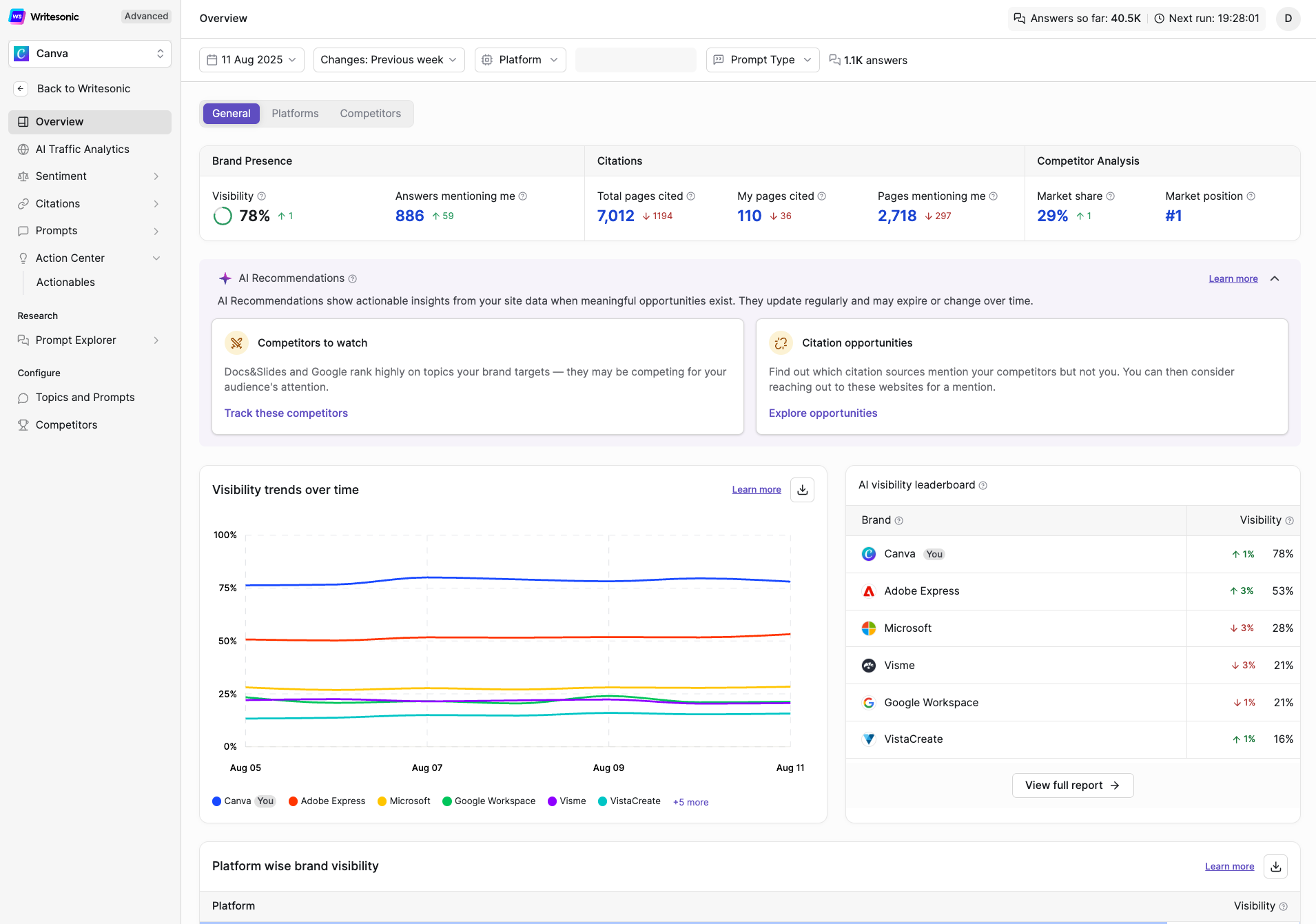
Dashboard Components
1. Brand Presence
Brand Presence metrics provide the foundational understanding of your brand's overall performance in AI-generated responses. These metrics serve as your primary indicators of GEO success, showing both the frequency and volume of your brand appearances across AI platforms. By tracking these metrics, you can quickly assess whether your content strategy effectively positions your brand in AI-powered conversations and identify areas for improvement.

Visibility Score
What this shows:
• Represents how often your brand appears in AI-generated responses when users ask relevant questions about your industry, products, or services.
• Aggregates performance across all monitored AI platforms and queries relevant to your business
• For example, here, 80% visibility means your brand appears in 8 out of 10 relevant AI responses.
• Includes both direct brand mentions and contextual references to your products or services
Why it matters:
• North star metric for GEO success - Unlike traditional SEO where you rank for specific keywords, this measures overall conversational presence
• Higher visibility scores translate directly to more potential customers discovering your brand through AI interactions
• Helps validate whether AI solutions position your brand as a relevant solution for that industry
Answers Mentioning Me
What this shows:
• Total count of distinct AI responses that include your brand name, products, or services
• Covers all tracked queries and platforms in your monitoring setup
• Includes both primary mentions (where you're the main focus) and secondary mentions (where you're listed among options)
• Each mention represents a unique opportunity for brand exposure
Why it matters:
• Every mention is a touchpoint with potential customers actively seeking solutions
• Growing mention counts indicate expanding brand presence in AI-generated content
• Helps track the volume impact of your GEO efforts over time
• Provides a quantifiable metric for measuring brand awareness growth in AI channels
2. Citations
The Citations section reveals how AI systems leverage your content as authoritative source material. This is a critical indicator of your content's trustworthiness and value in the AI ecosystem. Unlike visibility metrics that track brand mentions, citations specifically measure when your content is referenced to support AI-generated answers, directly impacting your domain authority and referral traffic from AI platforms.

Total Pages Cited
What this shows:
• Cumulative count of how many times your website's pages have been referenced as sources
• Includes all content types: homepage, blog posts, product pages, resource centers, documentation
• Multiple citations of the same page are counted separately
• Reflects the total volume of your content's reach as an authoritative source
Why it matters:
• High citation volumes signal content authority to both AI systems and users
• Directly impacts referral traffic as users click through to cited sources
• Helps identify which content types resonate most with AI algorithms
• Indicates your success in creating AI-friendly, authoritative content
• Influences future AI responses as systems learn to trust your domain
My Pages Cited
What this shows:
• Number of unique pages from your domain cited at least once in AI responses
• Reveals the breadth of your valuable content (vs. total citation volume)
• Shows whether authority comes from few highly-cited pages or many diverse pages
• Helps identify your content portfolio's overall performance
Why it matters:
• Diverse citation profile indicates comprehensive domain authority
• Reduces vulnerability to ranking changes affecting single pages
• Guides content optimization priorities:
- Identify high-performing content patterns to replicate
- Discover underperforming pages needing improvement
• Helps balance content investment across different topics and formats
Pages Mentioning Me
What this shows:
• Count of unique web pages across the internet that mention your brand
• Includes competitor sites, review platforms, news outlets, industry publications
• Tracks third-party mentions that contribute to your digital footprint
• Reflects organic brand reach beyond your owned content
Why it matters:
• Third-party mentions serve as powerful social proof influencing AI recommendations
• Multiple external sources discussing your brand signals market relevance to AI systems
• Helps identify:
- PR and partnership opportunities
- Brand sentiment trends
- Organic advocacy levels
• Strong third-party presence often correlates with higher AI visibility
3. Competitor Analysis
Competitor Analysis provides strategic intelligence about your market position and competitive landscape. This section helps you understand not just your absolute performance, but your relative standing among competitors. These insights are crucial for strategic planning, identifying market opportunities, and tracking the effectiveness of your GEO initiatives against competitive benchmarks.
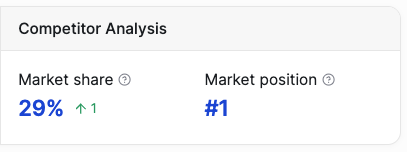
Market Share
What this shows:
• Your brand's percentage of total AI visibility within your competitive set
• Calculated as weighted average across all relevant queries and platforms
• Example: 29% market share means you account for 29% of all brand mentions among tracked competitors
• Updates dynamically as visibility scores change
Why it matters:
Essential for:
- Setting realistic growth targets
- Justifying marketing investments
- Tracking progress against competitors
• Helps identify whether you're gaining or losing ground • Valuable metric for board reports and stakeholder communications
Market Position
What this shows:
• Your numerical ranking among all tracked competitors
• Based on overall AI visibility scores
• #1 indicates market leadership, with lower numbers representing better positions
• Updates in real-time as competitive dynamics shift
Why it matters:
• Provides instant competitive context for your performance
• Creates clear, achievable goals (e.g., "move from #3 to #2 by Q3")
• Serves as a powerful motivator for teams
• Offers simple success metric for leadership reporting
• Helps track effectiveness of competitive responses
4. Visibility Trends Over Time
This time-series visualization tracks the evolution of your brand's AI visibility, providing crucial insights into momentum, seasonality, and the impact of your optimization efforts. By comparing your trajectory against competitors, you can identify market shifts, validate strategic decisions, and predict future performance trends. This historical perspective is essential for understanding whether short-term fluctuations represent meaningful changes or normal variability.
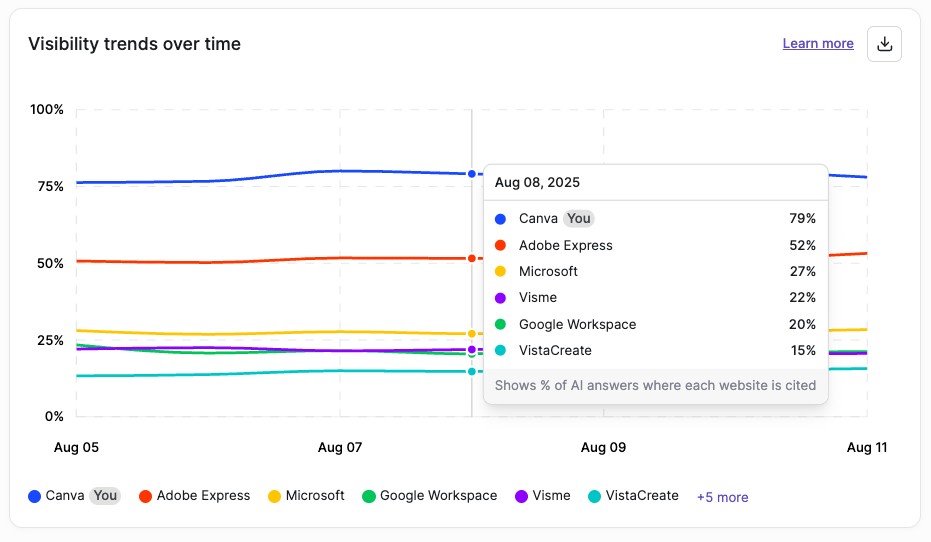
What this shows:
• Interactive line graph displaying visibility percentage changes over selected time periods
• Separate trend lines for your brand and each tracked competitor
• Hover functionality reveals exact percentages for specific dates
• Adjustable time ranges from daily to quarterly views
• Visual representation of momentum and trajectory
Why it matters:
• Critical for understanding GEO impact and external factors
• Enables pattern recognition:
- Upward trends validate strategy effectiveness
- Downward trends demand investigation
- Seasonal patterns inform planning
• Helps correlate visibility changes with: - Content launches
- Algorithm updates
- Marketing campaigns
- Competitive actions
• Provides data for predictive modeling and forecasting
5. AI Visibility Leaderboard
The AI Visibility Leaderboard offers a comprehensive competitive ranking that helps you understand the full market landscape at a glance. This real-time ranking system tracks all players in your space, from established leaders to emerging challengers, providing essential context for your strategic planning and competitive positioning efforts.

What this shows:
• Comprehensive ranking table of all monitored brands in your competitive set
• Ordered by visibility scores from highest to lowest
• Includes visibility percentage and period-over-period changes
• Real-time updates as new data is processed
• Shows both established players and emerging competitors
Why it matters:
• Offers immediate competitive intelligence at a glance
• Helps identify:
- Fast-rising competitors worth analyzing
- Declining competitors presenting opportunity
- Unexpected entrants to your space
• Useful for competitive briefings and strategic planning • Tracks effectiveness of competitive responses to your initiatives • Reveals market consolidation or fragmentation trends
6. Platform-wise Brand Visibility
Understanding your performance across different AI platforms is crucial as each platform serves distinct user demographics and use cases. This breakdown helps you identify platform-specific strengths and weaknesses, enabling targeted optimization strategies and efficient resource allocation. Different platforms may favor different content types or have unique ranking factors that affect your visibility.
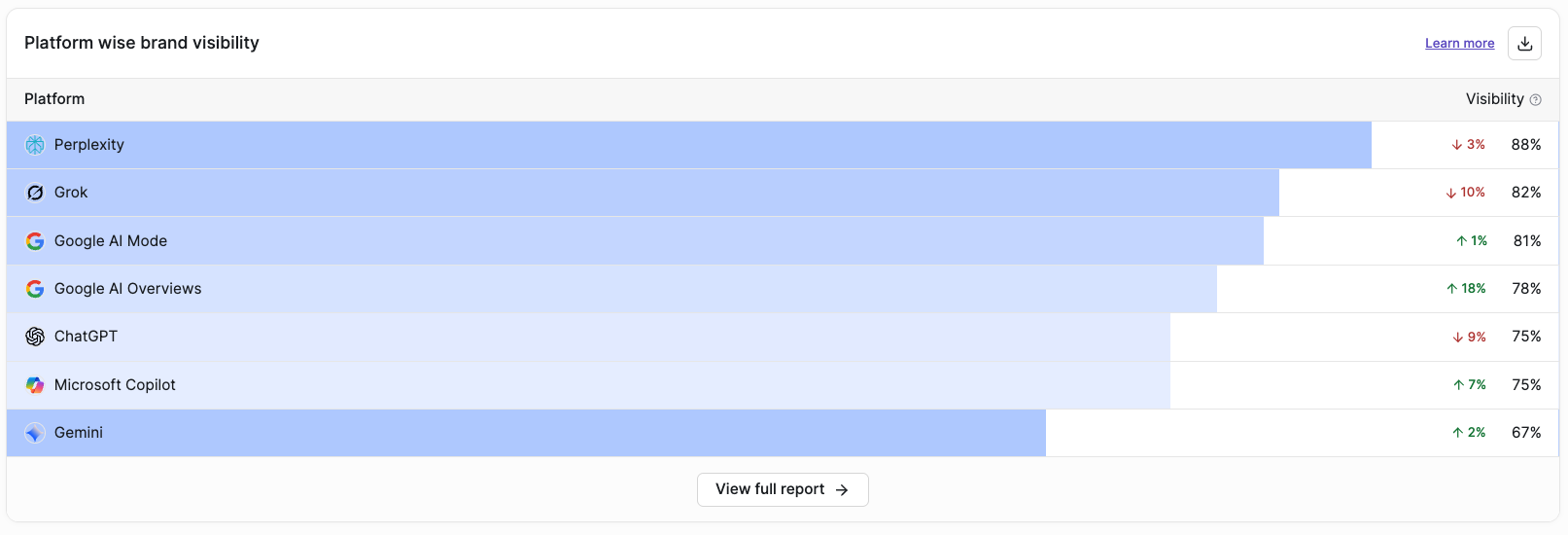
What this shows:
• Individual visibility percentages across major AI platforms:
- Perplexity
- Grok
- Google AI Mode & AI Overviews
- ChatGPT
- Microsoft Copilot
- Gemini
• Platform-specific performance metrics • How each platform's unique algorithm affects your presence
Why it matters:
• Different platforms serve different user demographics
• Enables strategic resource allocation:
- Prioritize platforms where target audience is most active
- Focus on platforms with greatest growth potential
- Identify quick-win optimization opportunities
• Helps diagnose technical issues affecting specific platforms • Guides platform-specific content optimization strategies • Reveals where competitors might be vulnerable
7. Which Rank is Your Brand Mentioned in Answers?
Position within AI responses is as important as frequency of mentions. This distribution analysis reveals whether your brand typically appears as the primary recommendation or falls lower in the list. Understanding your ranking distribution helps identify opportunities to improve prominence without necessarily increasing total mentions, directly impacting user engagement and conversion rates.
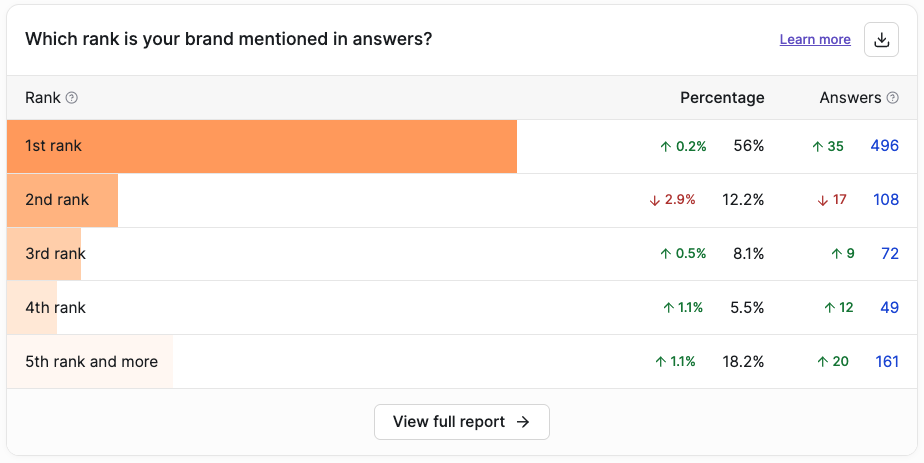
What this shows:
• Distribution of your brand's ranking positions within AI responses
• Bar chart showing percentage and count for each position (1st through 5th+)
• Reveals whether you're typically the primary, secondary, or tertiary recommendation
• Example: 56% in 1st position means you're the top recommendation in over half your mentions
Why it matters:
• Position dramatically impacts user engagement:
- First recommendations receive 3-5x more attention than third
- Higher positions drive significantly better click-through rates
• Even high visibility has limited impact if consistently in lower positions • Identifies optimization opportunities: - Queries where you rank poorly despite being mentioned
- Content improvements needed to climb positions
• Direct correlation with conversion rates and business impact
8. Market Share
The Market Share visualization provides an intuitive understanding of competitive dynamics through visual representation. This pie or donut chart makes complex market data immediately digestible, helping stakeholders quickly grasp market concentration, identify dominant players, and understand your relative position in the competitive landscape.
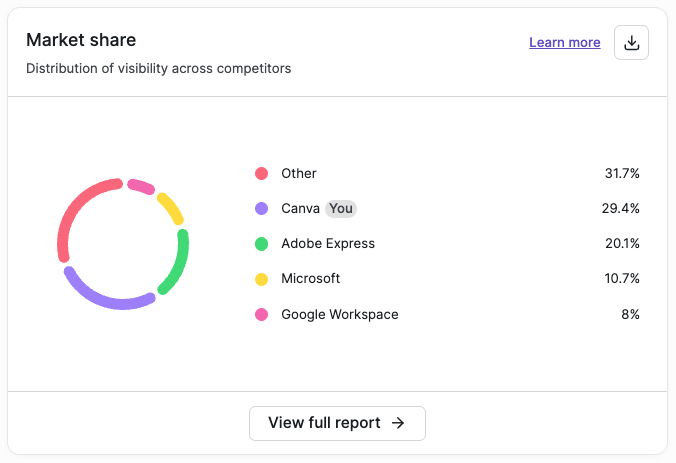
What this shows:
• Dynamic pie or donut chart visualizing visibility distribution
• Each segment represents a competitor's share of total visibility
• Your brand highlighted for easy identification
• Interactive elements reveal detailed metrics per competitor
• Smaller players grouped as "Others" for clarity
Why it matters:
• Makes market dynamics immediately apparent:
- Identifies market concentration vs. fragmentation
- Shows if dominated by few players or evenly distributed
• Powerful for stakeholder presentations and board reports • Helps identify: - Consolidation opportunities
- Potential partnerships
- Similar-sized competitors for benchmarking
• Tracks market shift trends over time • Reveals effectiveness of market share capture strategies
9. Top Cited Domains
This section reveals the authoritative sources that AI systems trust most in your industry. By understanding which domains dominate citations, you can identify content authority benchmarks, discover partnership opportunities, and understand the competitive landscape for content credibility. This intelligence guides both content strategy and relationship-building efforts.
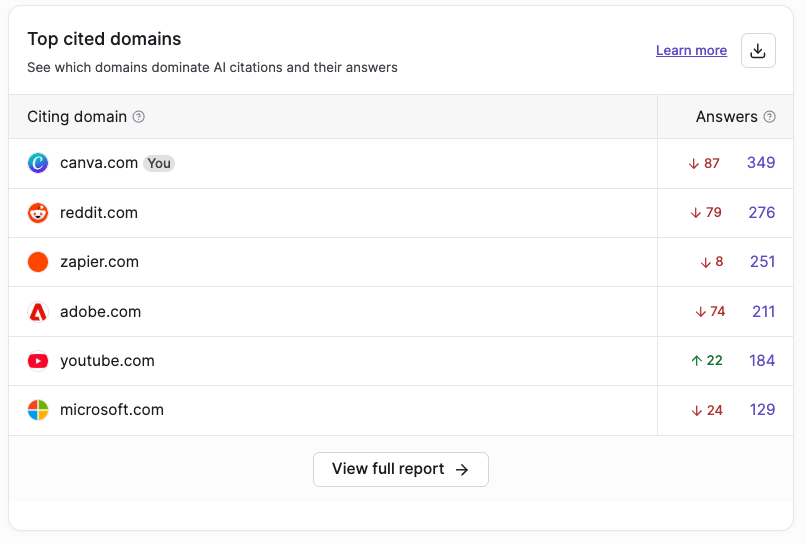
What this shows:
• Ranked list of domains most frequently cited as sources in your industry
• Includes citation counts and percentage of total citations
• Covers your domain, competitors, and third-party sources:
- Industry publications
- Wikipedia
- Government sites
- Academic sources
• Shows domains that collectively account for majority of citations
Why it matters:
• Reveals the competitive landscape for content credibility
• Identifies valuable targets for:
- Guest posting opportunities
- Strategic partnerships
- PR and outreach efforts
• Benchmarks your domain authority against others • Helps understand why certain sources are AI-preferred: - Content depth and structure
- Update frequency
- Technical optimization
• Guides content strategy based on successful patterns
10. Your Top Cited Pages
Your top-cited pages represent your most valuable GEO assets—the content that AI systems trust and reference most frequently. This analysis helps you understand what makes content successful in the AI ecosystem, providing templates for future content creation and identifying critical pages that deserve priority maintenance and optimization.

What this shows:
• Your highest-performing pages ranked by citation frequency
• Includes for each page:
- Full URL and title
- Citation count
- Percentage of your total citations
• Mix of content types (product pages, blogs, resources, documentation) • Reveals which formats and topics perform best
Why it matters:
• These pages are your most valuable GEO assets:
- Drive maximum authority and traffic
- Demonstrate your expertise areas to AI systems
• Provide templates for creating additional high-performing content • Common characteristics reveal success patterns: - Content depth and comprehensiveness
- Structure and formatting
- Data and example inclusion
- Update frequency
• Identify critical pages requiring: - Regular updates and maintenance
- Protection from technical issues
- Further optimization investment
11. Top Prompts Driving Visibility for Your Brand
Understanding the actual queries that trigger your brand mentions provides unparalleled insight into user intent and behavior. This section reveals the conversational nature of AI search, showing exactly how users phrase their questions and what information they seek. This intelligence is invaluable for content strategy, product development, and customer understanding.

What this shows:
• Specific user queries generating AI responses that mention your brand
• Listed with visibility percentage and mention frequency
• Range of prompt types:
- Broad industry questions
- Specific product comparisons
- Troubleshooting queries
- Buying advice and recommendations
• Represents actual user language and conversational patterns
Why it matters:
• Reveals actual user intent and pain points beyond traditional keywords
• Crucial for content optimization:
- Create content directly addressing high-value questions
- Optimize existing content to match user queries
- Develop comprehensive FAQ sections
• Identifies new market opportunities based on emerging prompts • Helps predict future content needs • Valuable for: - Sales team training on common questions
- Product development insights
- Customer support optimization
• Stays ahead of evolving user behavior in AI-powered search
Frequently Asked Questions (FAQs)
Q: How often is the Overview dashboard data refreshed?
A: • Daily updates with new data from AI platforms
• Most metrics reflect changes within 24 hours
• Some platforms may have slight processing delays
• Historical data preserved for trend analysis
Q: What's the difference between "Visibility" and "Citations"?
A: • Visibility: When your brand is mentioned or recommended in AI responses
• Citations: When your content serves as a source AI platforms reference
• You can have high visibility with low citations (brand known but content not cited)
• Or high citations with moderate visibility (trusted content but brand not always named)
Q: How many competitors should I track for optimal insights?
A: • Recommended: 5-10 direct competitors for focused analysis
• Include mix of:
- Market leaders
- Similar-sized competitors
- Emerging challengers
• Too many competitors dilute insights • Too few might miss important dynamics
Q: Why does my visibility vary significantly between AI platforms?
A: • Each platform uses different training data and algorithms
• Variations can indicate:
- Content optimization gaps
- Technical crawling issues
- Platform-specific user preferences
• Platform breakdown helps prioritize optimization efforts
Q: Can I customize which metrics appear on my Overview dashboard?
A: • Yes, dashboard supports customization:
- Highlight metrics relevant to your goals
- Create custom date ranges
- Adjust competitive sets
- Save specific views for quick access
Q: How do I improve my ranking position in AI answers?
A: • Create comprehensive, authoritative content
• Structure content with clear headers and sections
• Include relevant data, examples, and case studies
• Maintain content freshness through regular updates
• Build topical authority through content depth
• Ensure technical optimization for AI crawling
Q: What time period should I analyze for meaningful trends?
A: • Tactical adjustments: 7-30 day periods
• Strategic planning: 60-90 day trends
• Quarterly comparisons: Long-term progress and seasonal patterns
• Annual reviews: Year-over-year growth and market evolution
Q: How is market share calculated in a dynamic competitive landscape?
A: • Percentage of total visibility across all tracked competitors
• Weighted by query search volume and relevance
• Recalculated daily for current performance
• Ensures accurate market representation
Q: Can I export Overview data for presentations or reports?
A: • All visualizations and data tables exportable in multiple formats:
- CSV for data analysis
Q: What should I do if my visibility suddenly drops?
A: • Check if competitors show similar drops (platform-wide change)
• Review top-cited pages for technical issues
• Analyze which platforms drove the decline
• Identify specific prompts that lost visibility
• Use historical data to pinpoint timing and scope
• Implement targeted fixes based on findings
Updated 4 months ago
